
Ethereum, the world’s leading smart contract platform, has long grappled with scalability challenges – limited transaction throughput and high fees. StarkNet, an innovative layer-2 scaling solution, has emerged as a promising answer to these issues.
What is StarkNet?
StarkNet is a permissionless Validity Rollup, also known as a zero-knowledge rollup (ZK-rollup). It operates as a separate blockchain layer on top of Ethereum, processing transactions off-chain and then submitting validity proofs to the Ethereum mainnet. This approach dramatically increases throughput while maintaining Ethereum’s robust security.
How does StarkNet work?
StarkNet leverages the STARK (Scalable Transparent Argument of Knowledge) cryptographic proof system. This technology allows for the verification of a massive number of computations with a single proof, significantly reducing the data that needs to be stored on the Ethereum mainnet.
The core components of StarkNet include:
- Cairo: A dedicated programming language designed for writing StarkNet smart contracts, optimized for efficiency and provable execution.
- Sequencer: A node responsible for ordering transactions and generating STARK proofs.
- Verifier: A smart contract on Ethereum that verifies the validity of STARK proofs.
Key Advantages of StarkNet
- Scalability: StarkNet can process thousands of transactions per second, far exceeding Ethereum’s current capabilities.
- Low Fees: Transactions on StarkNet are significantly cheaper than on the Ethereum mainnet due to off-chain computation.
- Security: StarkNet inherits Ethereum’s security through validity proofs and data availability on the mainnet.
- Composability: StarkNet seamlessly interacts with other Ethereum applications, allowing for a rich ecosystem of composable dApps.
- General Purpose: StarkNet supports a wide range of use cases, including DeFi, NFTs, gaming, and more.
Use Cases of StarkNet
- DeFi: StarkNet is being adopted by various decentralized finance protocols, offering faster and cheaper transactions for lending, borrowing, trading, and other financial operations.
- NFTs: NFT marketplaces on StarkNet enable efficient minting and trading of non-fungible tokens.
- Gaming: StarkNet’s scalability opens up possibilities for blockchain-based games with complex economies and low transaction costs.
- Identity: Self-sovereign identity solutions can be built on StarkNet, offering secure and private management of digital identities.
Future Outlook
StarkNet has already garnered significant attention and adoption from developers and users alike. With ongoing development and a growing ecosystem of applications, it holds the potential to revolutionize the Ethereum landscape and pave the way for a more scalable and accessible blockchain future.
Important Considerations
While StarkNet offers numerous advantages, it’s important to be aware of potential challenges, such as:
- Centralization Risks: The current sequencer model may raise centralization concerns, but efforts are underway to decentralize this component.
- Technical Complexity: The technology behind StarkNet is complex, posing challenges for adoption and development.
Conclusion
StarkNet represents a significant step forward in addressing Ethereum’s scalability limitations. By leveraging the power of zero-knowledge proofs and off-chain computation, it unlocks a new era of possibilities for blockchain applications, empowering developers and users with faster, cheaper, and more secure transactions.

